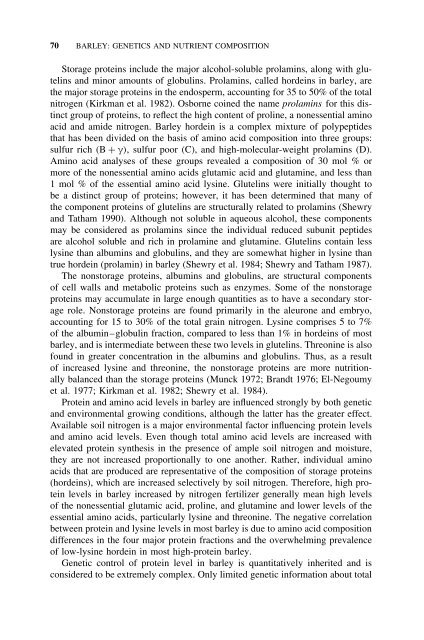Barley for Food and Health: Science, Technology, and Products
Barley for Food and Health: Science, Technology, and Products
Barley for Food and Health: Science, Technology, and Products
Create successful ePaper yourself
Turn your PDF publications into a flip-book with our unique Google optimized e-Paper software.
70 BARLEY: GENETICS AND NUTRIENT COMPOSITION<br />
Storage proteins include the major alcohol-soluble prolamins, along with glutelins<br />
<strong>and</strong> minor amounts of globulins. Prolamins, called hordeins in barley, are<br />
the major storage proteins in the endosperm, accounting <strong>for</strong> 35 to 50% of the total<br />
nitrogen (Kirkman et al. 1982). Osborne coined the name prolamins <strong>for</strong> this distinct<br />
group of proteins, to reflect the high content of proline, a nonessential amino<br />
acid <strong>and</strong> amide nitrogen. <strong>Barley</strong> hordein is a complex mixture of polypeptides<br />
that has been divided on the basis of amino acid composition into three groups:<br />
sulfur rich (B + γ), sulfur poor (C), <strong>and</strong> high-molecular-weight prolamins (D).<br />
Amino acid analyses of these groups revealed a composition of 30 mol % or<br />
more of the nonessential amino acids glutamic acid <strong>and</strong> glutamine, <strong>and</strong> less than<br />
1 mol % of the essential amino acid lysine. Glutelins were initially thought to<br />
be a distinct group of proteins; however, it has been determined that many of<br />
the component proteins of glutelins are structurally related to prolamins (Shewry<br />
<strong>and</strong> Tatham 1990). Although not soluble in aqueous alcohol, these components<br />
may be considered as prolamins since the individual reduced subunit peptides<br />
are alcohol soluble <strong>and</strong> rich in prolamine <strong>and</strong> glutamine. Glutelins contain less<br />
lysine than albumins <strong>and</strong> globulins, <strong>and</strong> they are somewhat higher in lysine than<br />
true hordein (prolamin) in barley (Shewry et al. 1984; Shewry <strong>and</strong> Tatham 1987).<br />
The nonstorage proteins, albumins <strong>and</strong> globulins, are structural components<br />
of cell walls <strong>and</strong> metabolic proteins such as enzymes. Some of the nonstorage<br />
proteins may accumulate in large enough quantities as to have a secondary storage<br />
role. Nonstorage proteins are found primarily in the aleurone <strong>and</strong> embryo,<br />
accounting <strong>for</strong> 15 to 30% of the total grain nitrogen. Lysine comprises 5 to 7%<br />
of the albumin–globulin fraction, compared to less than 1% in hordeins of most<br />
barley, <strong>and</strong> is intermediate between these two levels in glutelins. Threonine is also<br />
found in greater concentration in the albumins <strong>and</strong> globulins. Thus, as a result<br />
of increased lysine <strong>and</strong> threonine, the nonstorage proteins are more nutritionally<br />
balanced than the storage proteins (Munck 1972; Br<strong>and</strong>t 1976; El-Negoumy<br />
et al. 1977; Kirkman et al. 1982; Shewry et al. 1984).<br />
Protein <strong>and</strong> amino acid levels in barley are influenced strongly by both genetic<br />
<strong>and</strong> environmental growing conditions, although the latter has the greater effect.<br />
Available soil nitrogen is a major environmental factor influencing protein levels<br />
<strong>and</strong> amino acid levels. Even though total amino acid levels are increased with<br />
elevated protein synthesis in the presence of ample soil nitrogen <strong>and</strong> moisture,<br />
they are not increased proportionally to one another. Rather, individual amino<br />
acids that are produced are representative of the composition of storage proteins<br />
(hordeins), which are increased selectively by soil nitrogen. There<strong>for</strong>e, high protein<br />
levels in barley increased by nitrogen fertilizer generally mean high levels<br />
of the nonessential glutamic acid, proline, <strong>and</strong> glutamine <strong>and</strong> lower levels of the<br />
essential amino acids, particularly lysine <strong>and</strong> threonine. The negative correlation<br />
between protein <strong>and</strong> lysine levels in most barley is due to amino acid composition<br />
differences in the four major protein fractions <strong>and</strong> the overwhelming prevalence<br />
of low-lysine hordein in most high-protein barley.<br />
Genetic control of protein level in barley is quantitatively inherited <strong>and</strong> is<br />
considered to be extremely complex. Only limited genetic in<strong>for</strong>mation about total

















